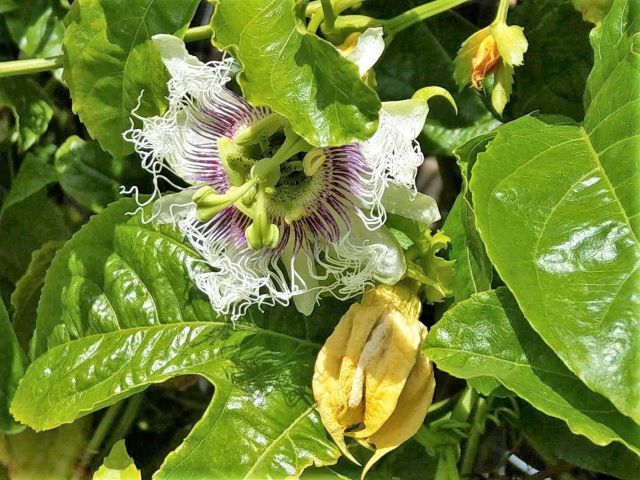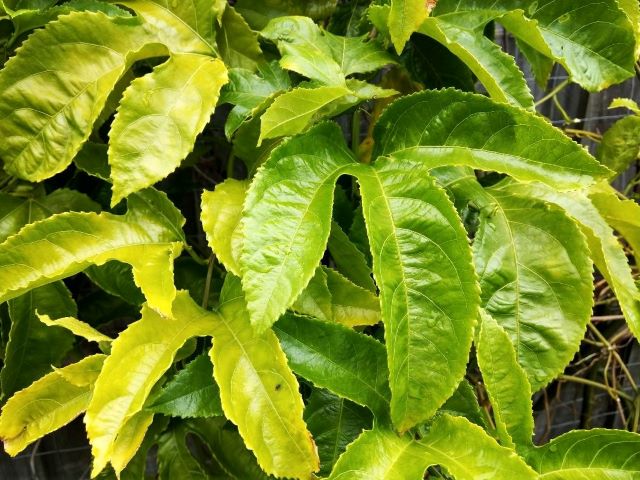Have you ever wondered whether passion fruit leaves are edible? Well, the good news is that yes, passion fruit leaves are edible! And they can be used in a variety of dishes. Now you can extend the harvest of greens from your garden by eating more of the plants, and vines, you already grow in your garden. Let’s find out more.

Table of Contents
What Are Passion Fruit Leaves?
Passion fruit leaves are the leaves grown on a passion fruit vine (Passiflora edulis). They are oblong with lobes and measure between 3-8 inches (7-20 cm) in size, depending on the variety. Usually, the surface of the passion fruit leaf is a smooth dark green color and the underside of the leaf is lighter with a matte texture.
The passion fruit vine itself is a fast and vigorous grower that requires support in the form of a strong trellis or trained along a fence. I grow passion fruit up a trellis attached to the fence. Not only does this provide great support, but it also helps to hide an unattractive and boring fence!
As a short-lived perennial plant, passion fruit vines generally live for 5-6 years, after which time you will need to replace your vine. If you have the space, you could plant a new passion fruit vine every few years to keep up your supply of delicious passion fruits.
Passion fruit vines are fast growers, spreading up to 20 ft (6 meters) in one year. Though you might still be waiting up to 18 months for your first passion fruits to develop and ripen. So it makes sense to consider using the edible greens of the passion fruit leaves growing on the vine and utilizing them as another food source.
Can You Eat Passion Fruit Leaves?

We are all familiar with the delicious fruit produced on the passion fruit vine but did you know you can also eat passion fruit leaves? Yes, that’s right, passion fruit leaves are edible and can be eaten raw or cooked like other leafy green vegetables.
Eating passion fruit leaves can increase the amount of food you can harvest from your garden (though this does not extend to ornamental passion fruit leaves).
What Do Passion Fruit Leaves Taste Like?
Passion fruit leaves taste like mild leafy greens, similar to spinach.
As with many green vegetables, passion fruit leaves do have a slightly bitter flavor that can be reduced by blanching the leaves first. If you don’t mind the hint of bitter flavor then this step can be skipped and the passion fruit leaves can be added straight into a dish.
Can You Eat Passion Fruit Leaves Raw?
Passion fruit leaves can be eaten raw and are best when young and tender when eaten for this purpose.
Older, more mature, passion fruit leaves are best used in a cooked dish as they’ll have a tougher texture and won’t be as delicious as the younger leaves when eaten raw.
Raw young and tender passion fruit leaves can be thinly sliced and added to salads.
How to Eat Passion Fruit Leaves
As well as eating passion fruit leaves raw, they can also be cooked and added to many dishes. Passion fruit leaves can be boiled, sauteed and stir-fried.
Passion fruit leaves can be used in soups or pasta sauces. They can be added to curries and stir-fries and even quiches.
A popular way to eat passion fruit leaves is in sambals to accompany rice dishes.
Another way to use passion fruit leaves is to make a tea.
Passion fruit leaf tea is said to aid sleep by assisting insomnia and has anxiety-reducing qualities. Although I haven’t tried this myself, if you want to give it a go, you simply dry the passion fruit leaves on a low setting in the oven, crush up the dried leaves and put 1-2 tablespoons in a tea strainer to seep.
If you prefer to try the tea already prepackaged for you, here is a link for Passion Fruit Leaf Tea.
How to Prepare Passion Fruit Leaves for Cooking
When harvesting passion fruit leaves, be mindful to take what you need but not enough to affect the growth of the vine. This way the vine will continue to grow more leaves and support fruit development.
Growing passion fruit vines organically, without harmful chemicals, will mean the leaves will be healthy. But be sure to give them a good wash to remove any dirt before eating them.
For older passion fruit leaves, I prefer to remove any thicker stems, which can be hard and tough to eat, but this isn’t necessary. Especially if slice the leaves finely.
Then simply slice up the passion fruit leaves as you would any green leafy veg. I prefer to slice the leaves thinly so they cook quickly, and then toss them into a dish.
Passion Fruit Leaves Recipe Ideas
Although there are not too many published recipes for passion fruit leaves, I did find the following yummy side dishes.
Passion Fruit Leaves Sambola (Raw Passion Fruit Leaves Salad) – from Food Corner. As well as using raw passion fruit leaves, this recipe combines grated coconut, chili, onions, and tomatoes along with seasonings including lime juice. This dish is delicious as a side dish with rice and curry.
Passion Fruit Leaves Mellum – from Anomas Kitchen. Along with passion fruit leaves, this recipe includes coconut, onions, garlic, chili, curry leaves and turmeric. The ingredients for this recipe are cooked to make up this yummy side dish.
Final Thoughts
If you have a passion fruit vine growing at home, why not consider using more of the vine than just the fruit? As we have seen, passion fruit leaves are edible and delicious added to many dishes as you would any leafy green vegetable. Why not give them a try? They just might surprise you!
Further reading:
- Eating Beet Greens With Recipe Ideas
- Are Pumpkin Leaves Edible? (And How to Eat Pumpkin Leaves)
- Can You Eat Radish Greens? (And How to Eat Them)
- Eating Carrot Tops With Recipe Ideas
- Are Ginger Leaves Edible? (And how to eat them!)
- Eating Turnip Greens With Recipe Ideas
- Eating Watermelon Rind With Recipe Ideas
